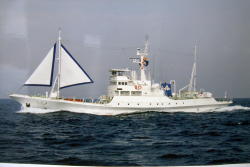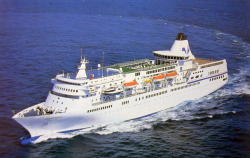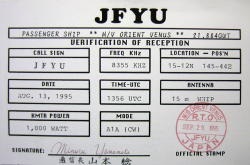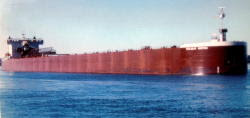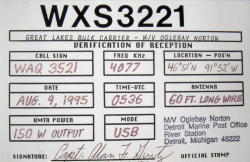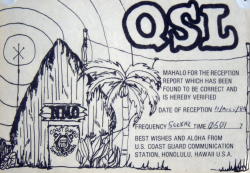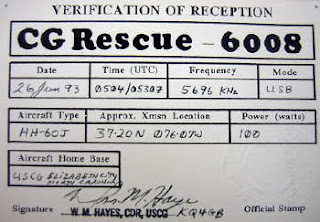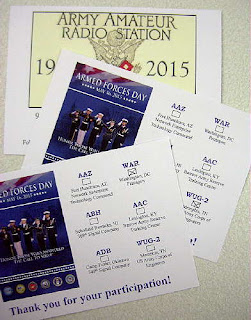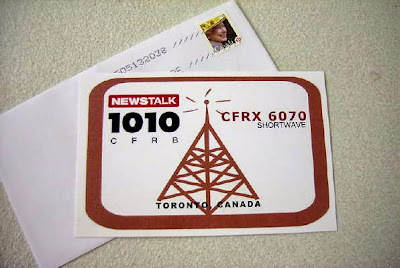Posts Tagged ‘shortwave’
 DX’ing The ‘Utilities’
DX’ing The ‘Utilities’
 After building the house here on Mayne Island, in the early 90's, it was several years until I was able to set up a dedicated station. In the meantime, I limited my radio activities strictly to listening. I had a nice Icom R-71A set up in a hall closet and spent my radio-time, mostly on weekend evenings, listening to maritime CW, HF aeronautical traffic and, of course, NDBs below the broadcast band. My HF receiving antenna consisted of three inverted-V's ... one for 160m, the second for 80m and the third for 40m ... all fed from the same coaxial line at the top of a 70' Balsam. It didn't take long to realize what an exceptional radio location I had, living right at the edge of the ocean, with dozens of miles of saltwater in most directions other than due west.
After building the house here on Mayne Island, in the early 90's, it was several years until I was able to set up a dedicated station. In the meantime, I limited my radio activities strictly to listening. I had a nice Icom R-71A set up in a hall closet and spent my radio-time, mostly on weekend evenings, listening to maritime CW, HF aeronautical traffic and, of course, NDBs below the broadcast band. My HF receiving antenna consisted of three inverted-V's ... one for 160m, the second for 80m and the third for 40m ... all fed from the same coaxial line at the top of a 70' Balsam. It didn't take long to realize what an exceptional radio location I had, living right at the edge of the ocean, with dozens of miles of saltwater in most directions other than due west.I really enjoyed following evening airline flights across both the North and South Atlantic, and in the early winter afternoons, following the commercial air-traffic all over Africa. Even though listening on 5 or 6MHz, I was amazed at how strong the signals from airliners over Africa at 30,000 feet or more could become, this far to the west. In the early mornings, directions were reversed and traffic from the far east, right into India, was fairly common. Often, small single-engine planes, usually run by various missionaries, could be heard while on the ground, taxiing at remote field locations and calling in via HF radio to request takeoff and flight-following.
Now, QSL's have always been one of my top radio interests and it wasn't long before I started sending and collecting verifications for both the aircraft and the ships I was hearing ... once I had figured out how to get my reception reports to their proper destinations. A very small portion of my 'utility' QSL collection is shown below. For the most part, it consists of PRC's or 'Prepared Reply Cards', with blank portions to be filled-in by the verification signers. Surprisingly, my return rate was around 90% and verifications were often returned with long, hand-written letters and numerous photographs ... especially from the ship RO's, as I suspect their days at sea were often quite monotonous. Even many of the military and commercial aircraft pilots would return a handwritten note along with the filled-in verification card, which I found even more surprising. It seemed that most were very surprised to hear that their radio transmissions were even making it this far and could be heard so readily.
 Some of the most interesting catches came from the Pacific, with a large variety of ships operating out of Japan. There are probably still several maritime CW stations operating in Japan. Many of these were owned and operated by commercial fishing companies and could be heard working fleet vessels throughout the Pacific on their daily CW skeds.
Some of the most interesting catches came from the Pacific, with a large variety of ships operating out of Japan. There are probably still several maritime CW stations operating in Japan. Many of these were owned and operated by commercial fishing companies and could be heard working fleet vessels throughout the Pacific on their daily CW skeds.This interesting catch from the North Pacific was the Japanese 'fisheries research vessel' 'M/V FUJI MARU'. She was about 1200 miles NW of her CW contact, JNA in Tokyo.
A Japanese cruise-ship, the 'M/V ORIENT VENUS' was logged early one summer morning while working JNA on 8355 KHz CW. Her position indicates she was in the Mariana Islands.
One of my first catches from the Great Lakes
was the 'M/V Oglebay Norton', a huge bulk
carrier out of Detroit. Her 150W signal was loud and clear late one August evening while in contact with WLC, Rogers City Radio.
 The U.S. Coast Guard is still one of the best QSLers around.
The U.S. Coast Guard is still one of the best QSLers around.Several of their stations will QSL with a nice printed card.
NMC (San Francisco) and NMO (Hawaii) were two
catches, regularly heard on the old 500 KHz calling
frequency.
Stormy weather often provided a good chance
to catch a search and rescue mission in progress.
'Rescue 6008' was an HH-60J helo enroute from
Chesapeake Bay to Elizabeth City, North Carolina during
a midnight rescue operation.

Although not my farthest HF maritime catch,
this was one of the most surprising. 'C4PC'
was heard early one February evening on 8 MHz CW, when conditions seemed terrible. No other ships were heard on the band at the time. As I learned later, the 'M/V MAIROULI' was at anchor near Beirut, Lebanon, a distance of nearly 7,000 miles from Mayne Island.
.... cont'd
 Army-Navy Crossband
Army-Navy Crossband
Yesterday's mail brought an official - looking envelope from the U.S. Army! It contained a very nice letter from Fort Huachuca, Arizona, thanking me for participating in the '66th Military-Amateur Crossband Test' as well as three QSL's for the Army-affiliated contacts that I had made back in May.
During the activity, I was able to work Army stations AAZ (AZ), WAR (Pentagon), WUG-2 (TN) ... all on 20m via the crossband mode as the military stations transmitted outside of the band.
In addition to these three, two Navy stations were worked ... NWVC (IN) and NPD (TN) but it appears that 'Army' has beaten 'Navy' ... at least when it comes to QSL'ing!
 Historic adverts?
Historic adverts?
Thanks to Phil G4HFU (see earlier post) I have been reacquainted with the old PW adverts that got me dreaming over 50 years ago. I wonder if other blog readers can point me in the direction of old UK magazines and adverts? I was first interested in radio and SWLing in the early 1960s.
Back then, the world was a very different place. The Beatles were still in the future. We lived under the constant fear of all out nuclear war (I was terrified in the 1962 Cuba crisis) and most amateur DX was by CW or AM. Although RTTY was around, most digital modes were not. Magazines like Practical Wireless, Radio Constructor and Short Wave Magazine were filled with goodies I drooled over, but could not afford. Even now I do not like parting with money for amateur gear unless there is a good chance of getting very many years of good service from it.
 CKZU – 6160 Close-Up
CKZU – 6160 Close-Up
 |
| courtesy: googlemaps.ca |
On a weekend bike ride along the West Richmond dyke, Mark (VA7MM) snapped this wonderful close-up view of the system:
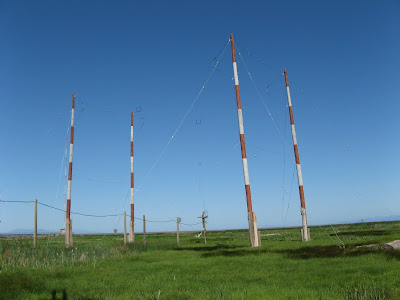 | ||||
| courtesy: VA7MM |
So the next time you are tuning around 40m, drop down a bit and see how their signal sounds at your location ... you may be pleasantly surprised.
 49m Canadians QSL’d
49m Canadians QSL’d
An e- mail report to long-time veri-signer and Ontario DX Association mainstay, Harold Sellers, brought a quick e-mail verification. I was hoping that CFVP would still be issuing a paper QSL but nowadays that is getting to be a rarer and rarer policy.
Harold also reports the following details about CFVP:
 |
| CFVP Tower courtesy: Harold Sellers |
Steve reports that CFRX is simulcasting CFRB (1010kHz) using 1000 watts into an omnidirectional vertical antenna. They have received several reports from Europe over the many years that he has been sending verifications.
Now to tackle CKZU!
 A 49m Bandscan
A 49m Bandscan

As indicated in an earlier blog, a planned scan of the 49m band was made a few nights ago ... one at 0400Z (10PM local) and another at 1200Z (5AM local). Both had a decidedly different flavor. Frankly I was surprised at the number of broadcasters and especially the number from Asia, China mainly, heard in the morning scan. One information source I found indicates that most of the strong shortwave signals from China are more designed for jamming than for program content.
My initial impression was that many of the more interesting low power targets from Central / South America and Africa may be a thing of the past but I may be wrong. The 'news' page, of the World Wide DX Club, seems to indicate that there are still lots of juicy targets out there if you are willing to put in the time to look for them, as many seem interested in doing. There also seems to be a larger variety of DX targets available in the higher bands such as 25m and 31m.
For the most part, these broadcasters don't fool around with QRP, and their signals are pretty dominant. Conditions of late have not favored Europe or Africa so there may be more activity from these regions than I think.
The following stations were logged with the Perseus SDR along and the 10'x20' loop / Wellbrook preamp, looping E-W, at 0400Z:
5810 EWTN (inSpan) Vandiver, Alabama 500kw
5830 WTWW (rel) Lebanon, TN 100kw
5850 Sun Power Radio (RMI) Okeechobee, FL 100kw
5890 WWCR (rel) Nashville, TN 100kw
5910 NHK Radio Japan Issoudun, France 100kw
5920 WHRI (rel) s/off Cypress Creek, SC 250kw
5920 Radio Romania Galbeni 300kw
5935 WWCR (rel) Nashville, TN 100kw
5970 Radio Italia (in Portuguese) Belo Horizonte, Brazil 10kw
5980 Channel Africa s/off Meyerton, SA 250kw
5985 NHK World Radio Japan (in Span) Okeechobee, FL 100kw
6000 Radio Habana Cuba Titan Quivican 250kw
6020 Radio Gaucha s/off Porto Alegre, Brazil 10kw
6030 Radio Marti Greenville, NC 250kw
6040 Radio RB2 (in Portuguese) Curibata, PR 10kw
6050 unid / weak
6060 Radio Habana Cuba La Habana 100kw
6070 CFRX Toronto, ON 1kw
6090 Caribbean Beacon (rel) Anguilla 100kw
6125 Deutsche Welle s/off Manama, Bahrain 250kw
6160 CKZU Vancouver, BC 500w
6165 Radio Habana Cuba La Habana 100kw
6175 Voice of Vietnam Cypress Creek, SC 250kw
6180 Radio Nacional Brazilia Brasilia 250kw
6185 XEPPM Radio Educacion Mexico City 1kw
These stations were logged at 1200Z, using the same system:
5830 WTWW Tennessee 250kw
5875 BBC Nakhon Sawan (Thailand) 250kw
5915 China Radio Int'l Hohhot 100kw
5925 Voice of Vietnam 2 Hanoi 50kw
5935 PBS Xizang Lhasa-Baiding 100kw //6110
5955 China Radio Int'l Beijing 150kw
5970 PBS Gannan Hezuo 15kw
5975 CNR 8 Beijing 100kw
5985 Myanmar Radio Yangon 25kw
5990 unid China Radio Int'l same interval sig as 5915
5995 Taiwan Xing Xing Kuanyin sign-on 10kw
6000 CNR 1 Beijing 100kw
6003 VOH Korea (S) 100kw
6015 KBS Hanminjok Bangsung 1 Hwaseong (S. Korea) 100kw
6020 weak / poss Radio Victoria Lima with time pips 3kw
6030 CNR 1 Beijing 100kw
6040 weak w/eastern music/ poss Air Jeypore India 50kw
6050 weak / poss RTM Malaysia 10kw
6055 weak w/continuous music / unid
6060 Radio Argentina Exterior General Pacheco 100kw
6065 CNR 2 Beijing 150kw
6070 Voice of Korea / in Japanese Kanggye 10kw
6080 PBS Hulun Buir Hailar (Mongolia) 10kw
6090 NHK World Radio Japan Ibaragi-Koga-Yamata 300kw
6095 KBS World Radio Kimjae (S.Korea) 250kw
6100 Radio Serbia Bijeljina 250kw
6105 Radio Taiwan Int'l Kouhu 100kw
6110 Voice of America / chinese Udon Thani (Thailand) 250kw
6110 PBS Xizang Lhasa-Baiding 100kw //5935
6115 Voice of Strait Fuzhou (PRC) 50kw
6125 CNR 1 Beijing 100kw
6155 CNR 2 Beijing 150kw
6160 CKZU Vancouver 500w / relay CBU AM
6165 Voice of Vietnam 4 Hanoi 50kw
6175 CNR 1 Beijing 100kw
6180 CNR unid but time pips match other CNRs
6180 Radio Taiwan Woofferton 250kw
6195 BBC Kranji (Singapore) 125kw
6200 Voice of Jinling Manjing (Singapore) 100kw
6280.14 Unid with music / poss SOH Xi Wang Zhi Sheng Tanshui (Taiwan) 100 watts
6365 Hand sent keyer CW with callups 7CJ 7CB 7FB QTC into nr/ltr groups
6389 similar to above but nr/ltr groups
6400 Pyongyang Kanggye (N. Korea) 50kw
6501 USCG NMO Honolulu with wx bdcst
6518 Voice of the People Kyonggi-do-Koyang (S. Korea) 50kw
6518 N. Korean jammer Kujang 250kw
6600 Voice of the People Kyonggi-do-Koyang (S. Korea) 50kw
6600 N. Korean jammer Kujang 250kw
6679 Honolulu Radio w/ aviation Volmet
6754 Trenton Volmet wx bdcst
The number of broadcasters using remote sites is also surprising. It seems that the relaying of program content for others is big business and for many countries, much cheaper than running their own 250kw stations.
Some links that I have found very useful for identifying SW BC stations:
http://www.geocities.jp/binewsjp/ic/bia15.txt
http://www.short-wave.info/
http://www.shortwaveschedule.com/
 Persistent Cycle 24
Persistent Cycle 24
 |
| courtesy: http://sdo.gsfc.nasa.gov/ |
Our Sun's latest rotation is showing several new large sunspot groupings, all very capable of unleashing a new round of solar flares and associated disruption ... if nothing else, Cycle 24 is persistent!
 |
| courtesy: http://sdo.gsfc.nasa.gov/data/ |
 |
| courtesy: http://www.swpc.noaa.gov/ |
The software gurus at NOAA have been busy once again, this time revamping several of their visual models to an 'animated' mode. The Ovation Auroral map is particularly interesting when run in this mode as it shows the auroral field's activity visually over the past 24 hours. The display gives one a new appreciation for the dynamics of such large scale events:
 |
| courtesy: http://www.swpc.noaa.gov/communities/radio-communications |
 |
| courtesy: http://www.dxmaps.com/ |

